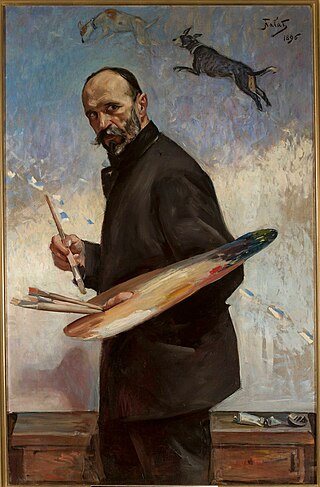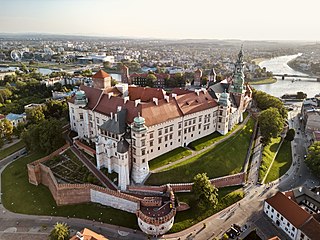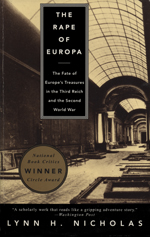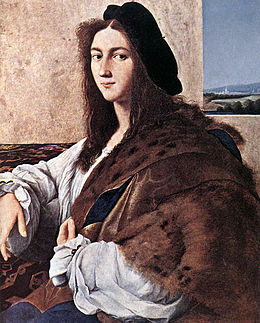
Krzeszowice is a town in southern Poland, situated in the Lesser Poland Voivodeship. As of 2004, its population was 9,993. Krzeszowice belongs to Kraków Metropolitan Area, and lies 25 kilometers west of the center of the city of Kraków. The town has a rail station, on a major route from Kraków to Katowice, and lies along National Road Nr. 79, which goes from Warsaw to Bytom. In 1928–1966 the town had the status of a spa. Krzeszowice has a sports club called Świt, founded in 1923.

Art theft, sometimes called artnapping, is the stealing of paintings, sculptures, or other forms of visual art from galleries, museums or other public and private locations. Stolen art is often resold or used by criminals as collateral to secure loans. Only a small percentage of stolen art is recovered—an estimated 10%. Many nations operate police squads to investigate art theft and illegal trade in stolen art and antiquities.

The Kunsthistorisches Museum is an art museum in Vienna, Austria. Housed in its festive palatial building on the Vienna Ring Road, it is crowned with an octagonal dome. The term Kunsthistorisches Museum applies to both the institution and the main building. It is the largest art museum in the country and one of the most important museums worldwide.

The Lady with an Ermine is a portrait painting widely attributed to the Italian Renaissance artist Leonardo da Vinci. Dated to c. 1489–1491, the work is painted in oils on a panel of walnut wood. Its subject is Cecilia Gallerani, a mistress of Ludovico Sforza, Duke of Milan; Leonardo was painter to the Sforza court in Milan at the time of its execution. It is the second of only four surviving portraits of women painted by Leonardo, the others being Ginevra de' Benci, La Belle Ferronnière and the Mona Lisa.

The Princes Czartoryski Museum – often abbreviated to Czartoryski Museum – is a historic museum in Kraków, Poland, and one of the country's oldest museums. The initial collection was formed in 1796 in Puławy by Princess Izabela Czartoryska. The Museum officially opened in 1878.

Prince Adam Karol Czartoryski is a Polish and Spanish aristocrat who is head of the Polish House of Czartoryski. He is related to both the Spanish royal family and to France's House of Orléans. In 2016, he sold the family art collection held in the Czartoryski Museum to the Polish state for approximately €100 million.

Julian Fałat was one of the most prolific Polish watercolorists, one of the country's foremost landscapists, and a leading impressionist.

The Wawel Royal Castle and the Wawel Hill on which it sits constitute the most historically and culturally significant site in Poland. A fortified residency on the Vistula River in Kraków, it was established on the orders of King Casimir III the Great and enlarged over the centuries into a number of structures around an Italian-styled courtyard. It represents nearly all European architectural styles of the Medieval, Renaissance and Baroque periods.

Nazi plunder was organized stealing of art and other items which occurred as a result of the organized looting of European countries during the time of the Nazi Party in Germany.
Lost artworks are original pieces of art that credible sources indicate once existed but that cannot be accounted for in museums or private collections or are known to have been destroyed deliberately or accidentally or neglected through ignorance and lack of connoisseurship.

Rescuing Da Vinci is a largely photographic, historical book about art reclamation and preservation during and after World War II, written by American author Robert M. Edsel, published in 2006 by Laurel Publishing.

The National Museum in Kraków, popularly abbreviated as MNK, is the largest museum in Poland, and the main branch of Poland's National Museum, which has several independent branches with permanent collections around the country. Established in 1879, the museum consists of 21 departments which are divided by art period: 11 galleries, 2 libraries, and 12 conservation workshops. It holds some 780,000 art objects, spanning from classical archeology to modern art, with special focus on Polish painting.

The Rape of Europa: The Fate of Europe's Treasures in the Third Reich and the Second World War is a 1994 book by Lynn H. Nicholas and a 2006 documentary film. The book explores the Nazi plunder of looted art treasures from occupied countries and the consequences. It covers a range of associated activities: Nazi appropriation and storage, patriotic concealment and smuggling during World War II, discoveries by the Allies, and the extraordinary tasks of preserving, tracking, and returning by the American Monuments officers and their colleagues. Nicholas was awarded the Légion d'Honneur by France.
Art theft and looting occurred on a massive scale during World War II. It originated with the policies of the Axis countries, primarily Nazi Germany and Japan, which systematically looted occupied territories. Near the end of the war the Soviet Union, in turn, began looting reclaimed and occupied territories. "The grand scale of looted artwork by the Nazis has resulted in the loss of many pieces being scattered across the world."

The National Museum in Poznań, Poland, abbreviated MNP, is a state-owned cultural institution and one of the largest museums in Poland. It houses a rich collection of Polish painting from the 16th century on, and a collection of foreign painting. The museum is also home to numismatic collections and a gallery of applied arts.
The Art Loss Register (ALR) is the world's largest database of stolen art. A computerized international database that captures information about lost and stolen art, antiques, and collectibles, the ALR is a London-based, independent, for-profit corporate offspring of the New York–based, nonprofit International Foundation for Art Research (IFAR). The range of functions served by ALR has grown as the number of its listed items has increased. The database is used by collectors, the art trade, insurers, and law enforcement agencies worldwide. In 1991, IFAR helped create the ALR as a commercial enterprise to expand and market the database. IFAR managed ALR's U.S. operations through 1997. In 1998, the ALR assumed full responsibility for the IFAR database, although IFAR retains ownership. In 1992, the database comprised only 20,000 items, but it grew in size nearly tenfold during its first decade.

Dagobert Frey was an Austrian art historian, a criminal responsible for the theft of the most valuable European and Polish collections from the Warsaw and Kraków museums and national art galleries during the Nazi German occupation of Poland.

The looting of Polish cultural artifacts and industrial infrastructure during World War II was carried out by Nazi Germany and the Soviet Union simultaneously after the invasion of Poland of 1939. A significant portion of Poland's cultural heritage, estimated at about half a million art objects, was plundered by the occupying powers. Catalogued pieces are still occasionally recovered elsewhere in the world and returned to Poland.

A Negress is an 1884 oil painting by the Polish artist Anna Bilińska. The painting was stolen from the National Museum in Warsaw during World War II and remained missing until it appeared at auction in 2011 and was returned to the museum in 2012.



















